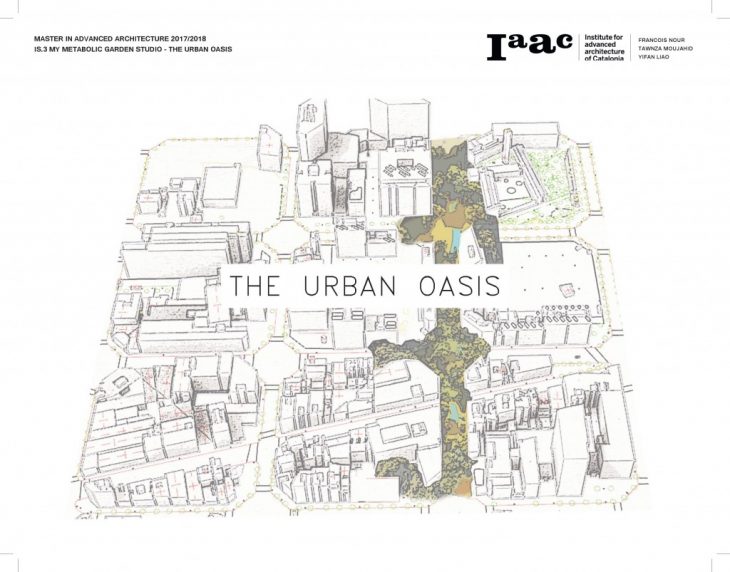
“Creating an engaging space, for the workers and students of Superilla,
generated by a visible, interactive greywater purification system,
in the shape of street furnitures and water features,
in order to raise awareness of water consumption.”
Intro:
Global warming is not a hoax. Statistics shows that constructions produce 50% of the CO2 emission on the planet. So, as architects and urbanists, we have the responsibility and ability to make a change. Our role is to rethink structures and infrastructures, in order to create a cleaner planet.
An infrastructure that could be significantly improved is the water system in Barcelona. Lots of citizen’s money are being thrown away due to inefficient ways of transferring water from faraway sources to Barcelona. All domestic water are transported via high energy-consumed processes, thus increases the use of fossil fuels. Water is wasted, instead of being reused, and the demand is increasing. A recent example is the urgency to import drinking water from Marseille during the 2008 drought.
Where water is wasted, CO2 is produced, and a scarce resource is vanishing. By reusing the water locally, we can reduce the water demand in the city. People will use their water twice but pay only one bill, and the pressure on the water suppliers will be reduced. Therefore, our project focuses on the local reuse of the blue gold.
How can we avoid water waste? How can water be reused in local plants to reduce the amount of energy spent on transferring it to far treatment plants? How can we raise people’s awareness about the amount of water they consume and waste on a daily basis?
1- The actual Water distribution system in Barcelona:
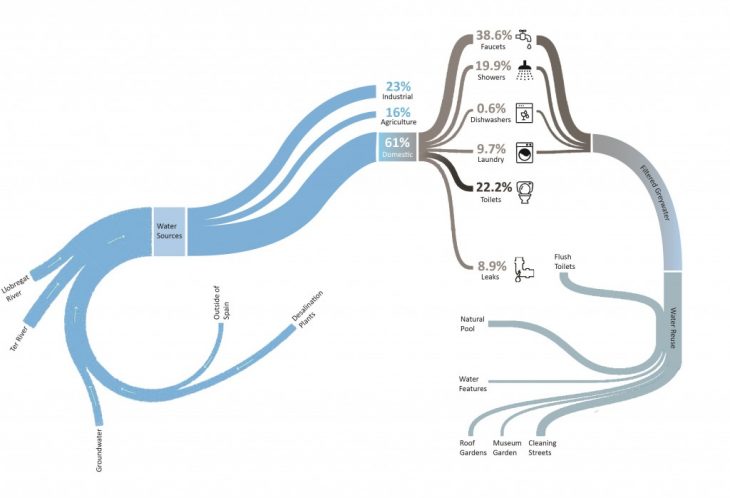
2- Case Study:

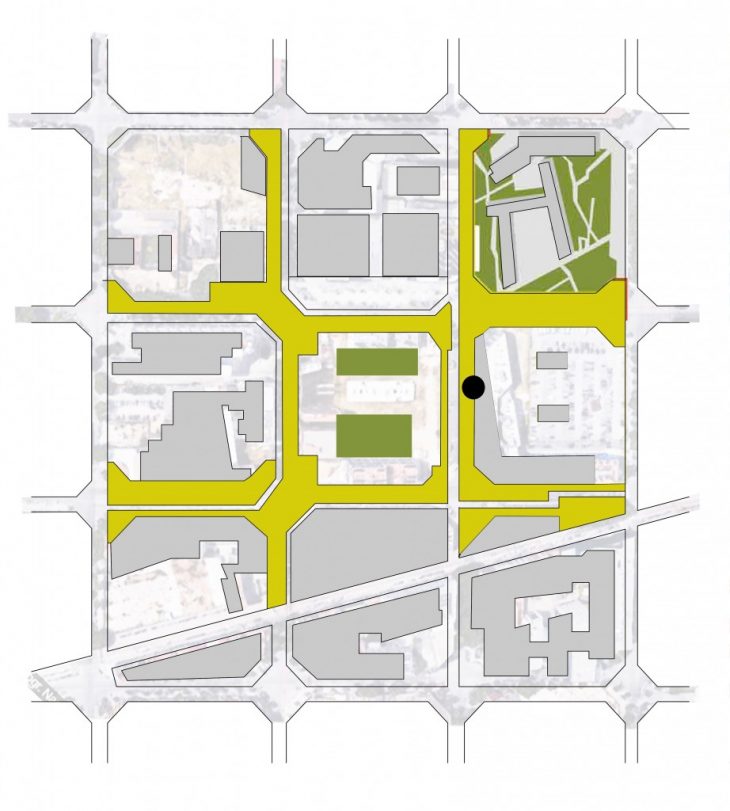
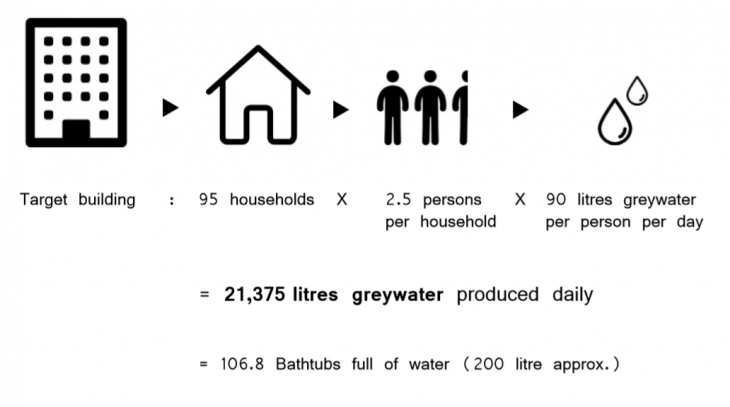
To grasp the amount of greywater is produced on a daily basis, we decided to study one of the buildings located in the Superilla. 95 Viviendas en Roc Boronat is the first multi-family building in Barcelona certified by the ICAEN that achieves maximum energy efficiency and minimum CO2 emission. The building is connected to the district energy network “Districlima” for heating and heating of water. Bimetal fuse is installed in dishwashers and washers; dual-flush toilets and water-saving faucets are also incorporated in the units.
3- The Site:
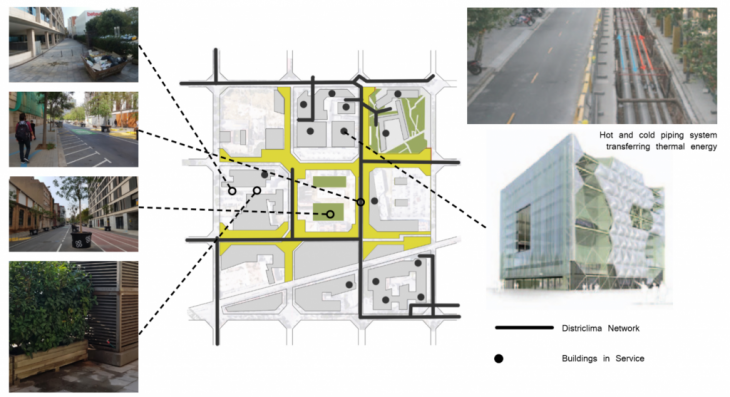
Our project is located in the neighbourhood of Poblenou, more specifically in the “Superblocks”, Barcelona’s plan to give streets back to the residents. A plan that will restrict traffic to a number of big roads, reduce pollution and turn secondary streets into citizen spaces for culture, leisure and the community.
After visiting the site, we observed that pedestrians were still walking on the raised walkways. The seperation still exists even though cars no longer pass through the roads. Also, we discovered there are existing infrastructures such as A/C water collecting to water planters and a district heating system called Districlima. Districlima supplies hot water and air conditioning to buildings in its network. The heat is generated by taking advantage of the steam produced through the incineration of municipal solid waste, and all the equipments of the plant is cooled using seawater. The Media-tic is one of the buildings that is in the Districlima network.
4- Water Study:
Domestic water passes through a treatment plant before arriving to our homes. After it is filtered, the following chemical residues are found: 1~1,4mg/L of chlorine, 80mg/L of coagulant agents, and 2~4mg/L of ozone.
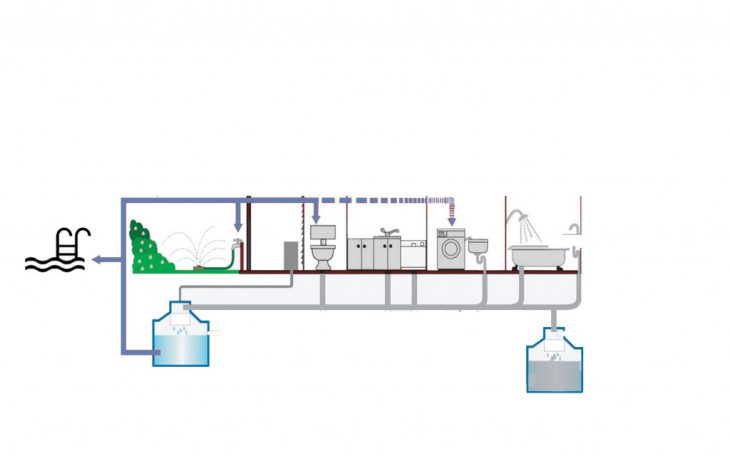
Used water is divided into black and greywater. Blackwater is waste water from toilets, and greywater is waste water from sinks, dishwashers, bathtubs, and washing machines. Blackwater is contaminated with bacteria, and can only be recycled as fertilizer for plants; Greywater has less contamination, and can be reused for irrigation, flushing toilets, cleaning cars and floors.
For these reasons, our focus will be on the filtration and recycling of greywater, which requires less chemical usage to clean and more economical results. Greywater can contain many organic products(oil, grease, hair), chemicals(soap, cleaning products), and microorganisms(bacterias, virus, protozoa, microalgae).
Our goal is to export the concept of knowledge, from infrastructures and buildings to these new public spaces. The name, the Urban Oasis, not only refers to the issue of treating waste water, but also implies the oasis of knowledge and awareness of water we will be showcasing around our site.
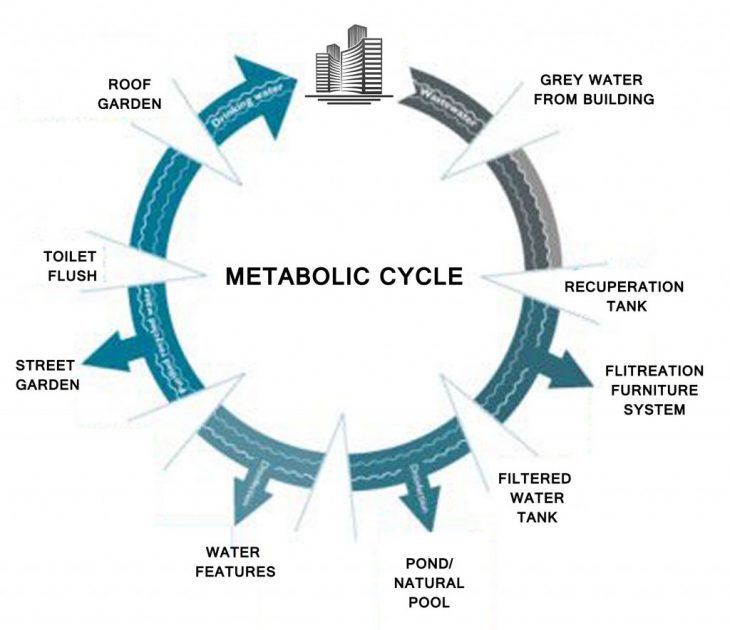 Our metabolic cycle starts from collecting greywater from buildings in the neighbourhood. After wards it goes through a series of filtering procedures, including rock, sand, activated carbon, and UV light. The filtered water is then reused to water the gardens on the roof, flush the toilets in the buildings, and create water features in the streets of Superilla.
Our metabolic cycle starts from collecting greywater from buildings in the neighbourhood. After wards it goes through a series of filtering procedures, including rock, sand, activated carbon, and UV light. The filtered water is then reused to water the gardens on the roof, flush the toilets in the buildings, and create water features in the streets of Superilla.
5- Phenomena:
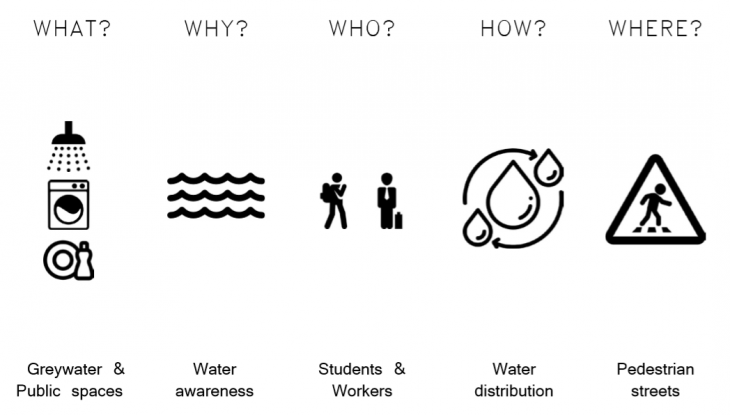
Greywater – Any washwater that has been used in the home, except water from toilets, is called grey water. Dish, shower, sink, and laundry water comprise 50-80% of residential waste water. This may be reused for other purposes through purification of water.
6- Technology:
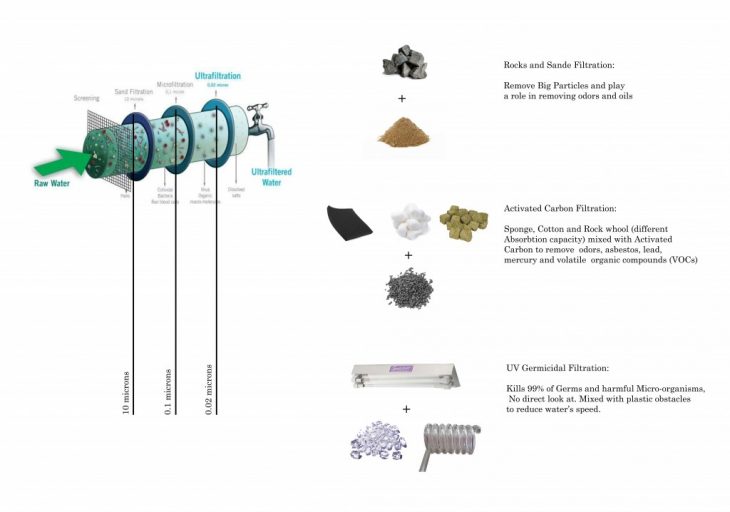
1. Rocks and Sand Filtration:
To remove big particles, odor and oil
2. Activated Carbon Filtration:
Sponge, Cotton and Rock wool (different absorbtion capacity) combined with activated carbon to remove odor, lead, mercury and volatile organic compounds (VOCs)
3. UV Germicidal Lamp Filtration:
Mixed with plastic obstacles to reduce flow speed, and to kill 99% of germs and harmful micro-organisms.
7- Prototyping:
a- Model:
The first attempt of our design is a metabolic pool with different depths and functions along a long alleyway in Superilla. On top of the pool, a walkway made out of wooden planks in different sizes and levels will serve as benches, picnic areas, and barbecue areas. The pool will become a refreshing pond during hot seasons, and warm foot spring during cold season.
The water for the pool will come from reclaimed greywater from the surrounding buildings. It will first go through a septic tank, a sand filter, and be pumped up into the pool. In addition, the water will pass through a Canadian wells system that keeps the pool a stable temperature throughout the year.
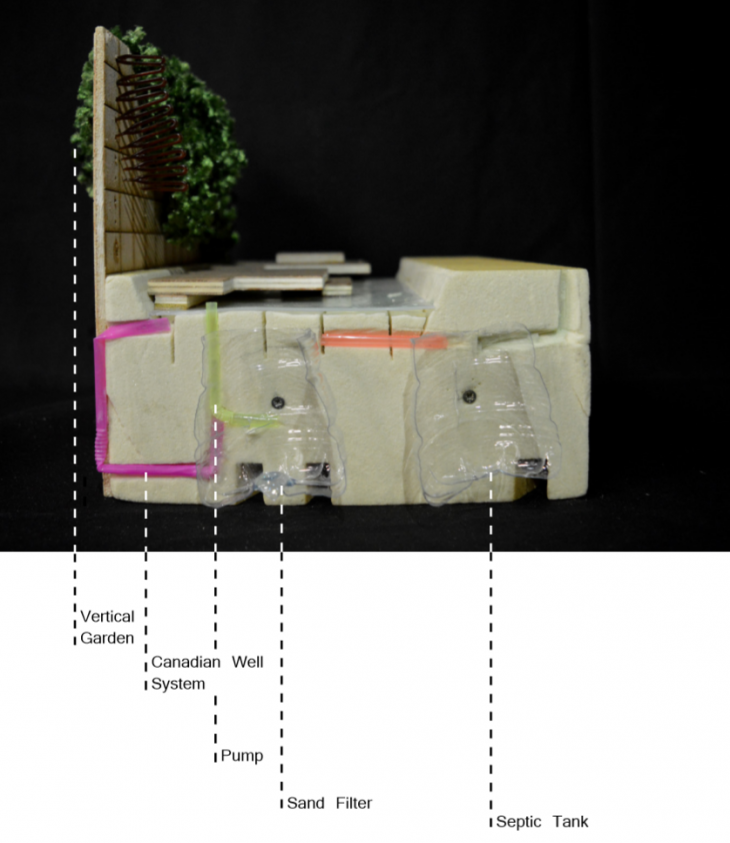
b- Filters test:
To find out which materials filter greywater best, we ran several experiments with different materials including charcoal, rocks, hay, saw dust, and soil. We discovered that water flows through the vertical filter too fast, and we need finer filter such as sand to combine with the rocks.
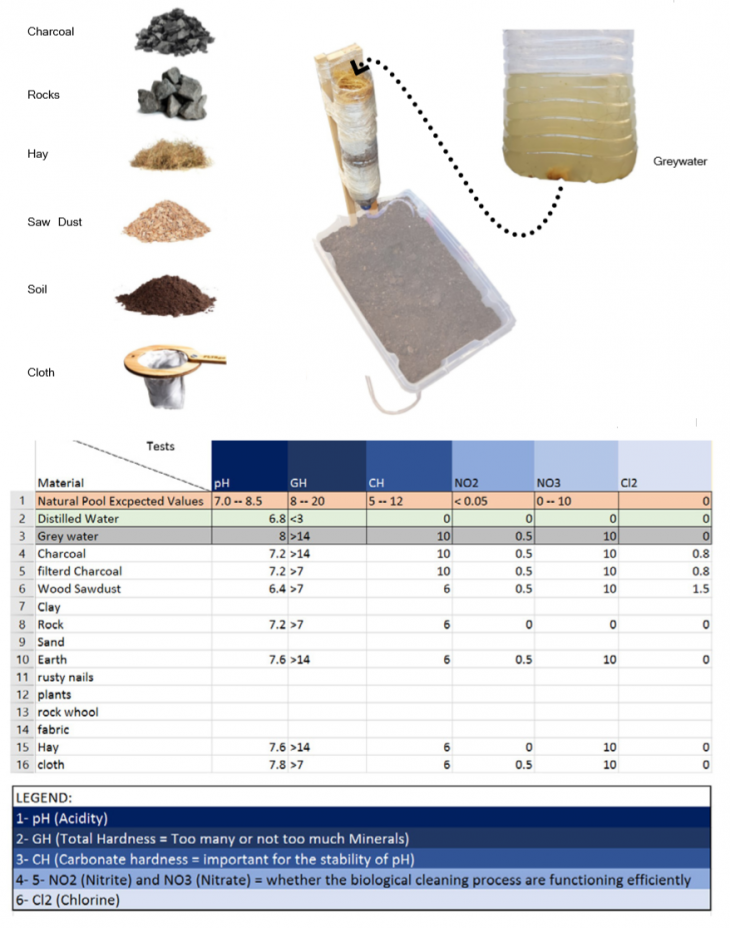
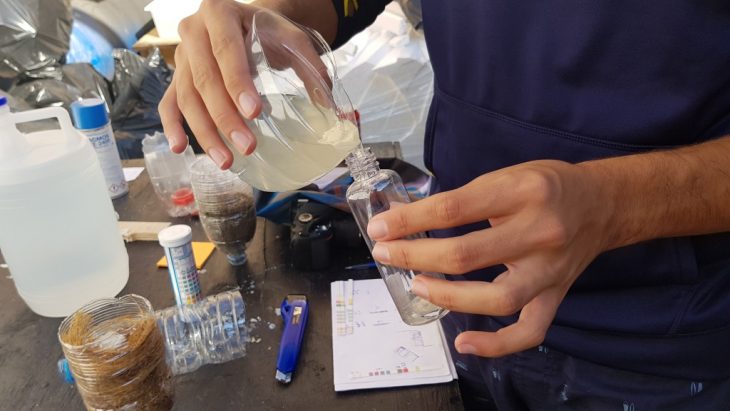
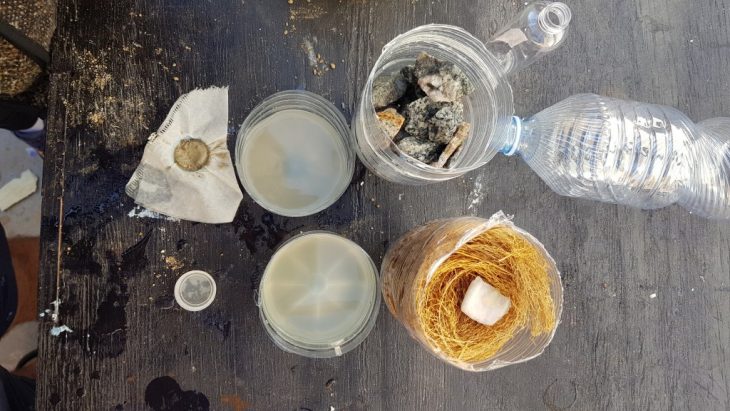
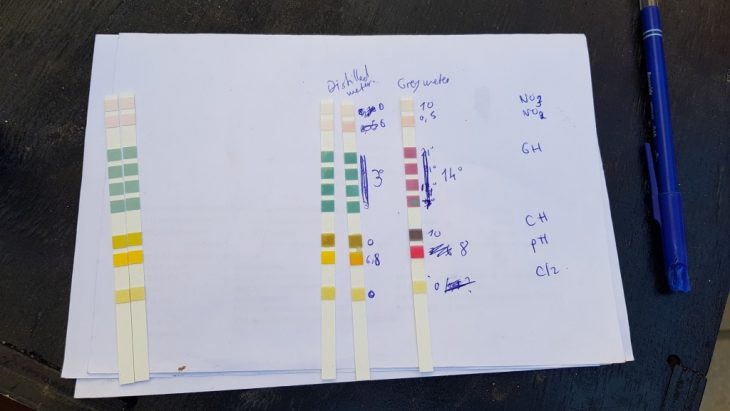
c- Filter Facade:
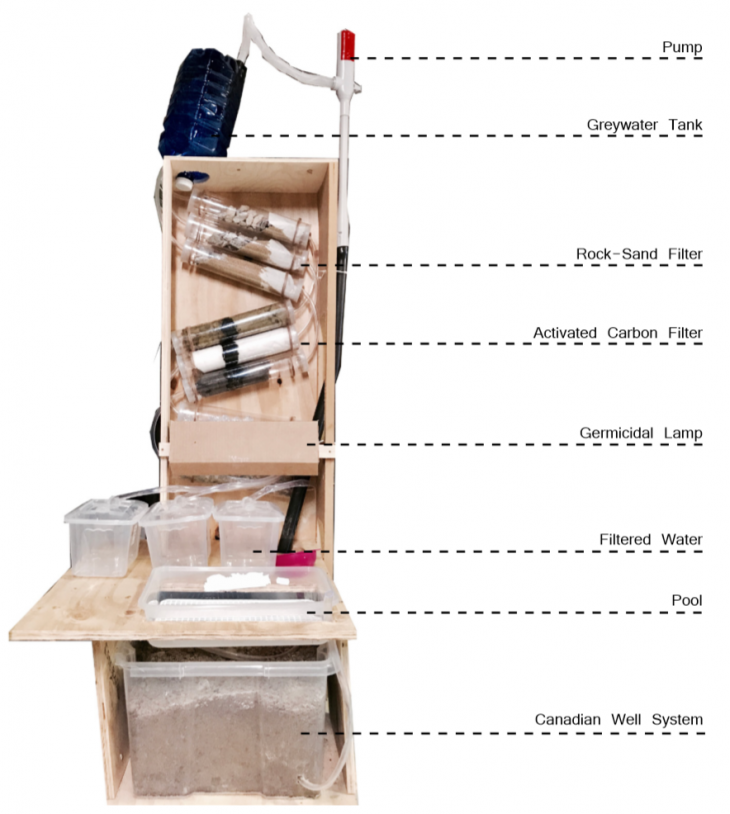
The final greywater filter experiment is divided into three steps. First, to test the proportions between rock and sand filter. Second, to test the combination of activated carbon with rock wool, cotton, and sponge to compare their water absorption capacity. Third, to test how different obstacles, clear crystals, plastic tube, and plastic scraps, slow down water flow in order to have effective UV light disinfection. In addition, the angle of the filter placements were adjusted for more effective results.
d- The skin:
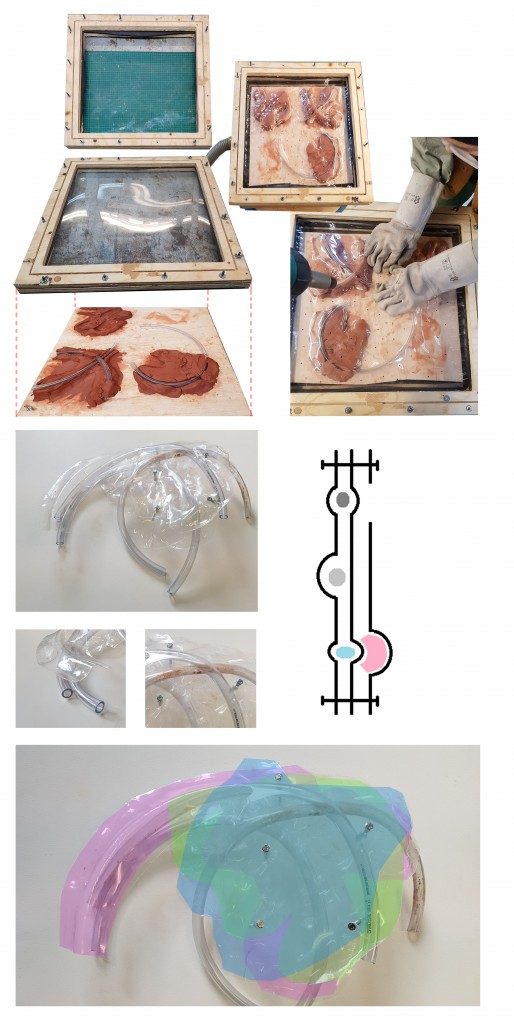 This prototype is an attempt to combine all the systems in one multi-layered skin. The systems include greywater filtration, passive water heating, and light. We used clay to thermoform PETG sheets to create an organic shape, to allow for smooth water flow. The end result wasn’t precise, since we didn’t allow enough time for the clay to dry.
This prototype is an attempt to combine all the systems in one multi-layered skin. The systems include greywater filtration, passive water heating, and light. We used clay to thermoform PETG sheets to create an organic shape, to allow for smooth water flow. The end result wasn’t precise, since we didn’t allow enough time for the clay to dry.
e- Final Prototype:
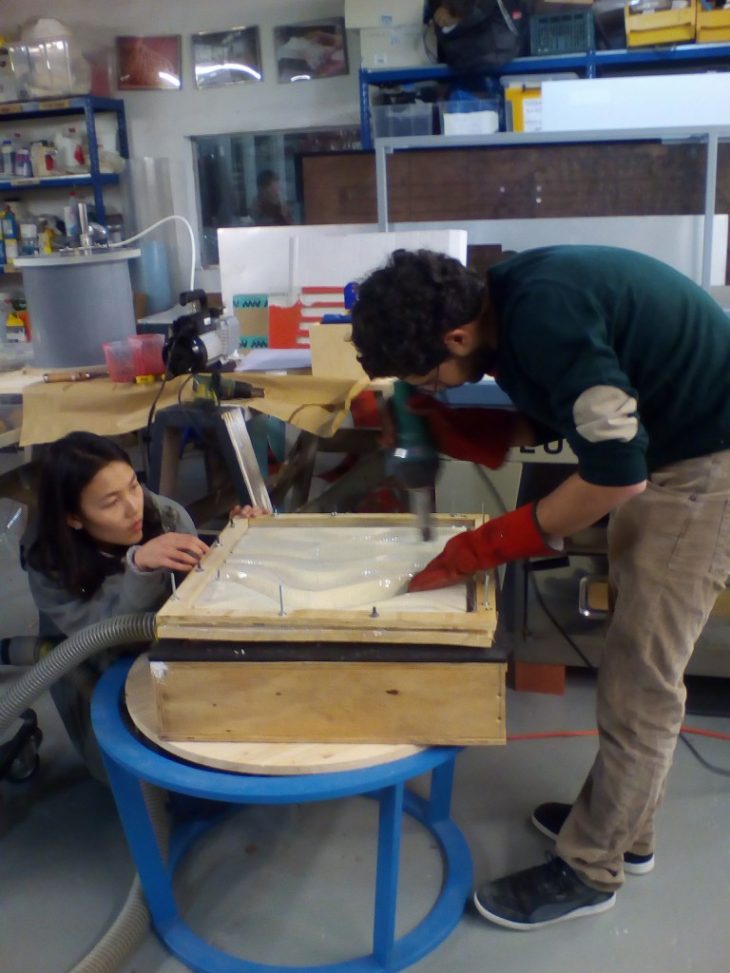
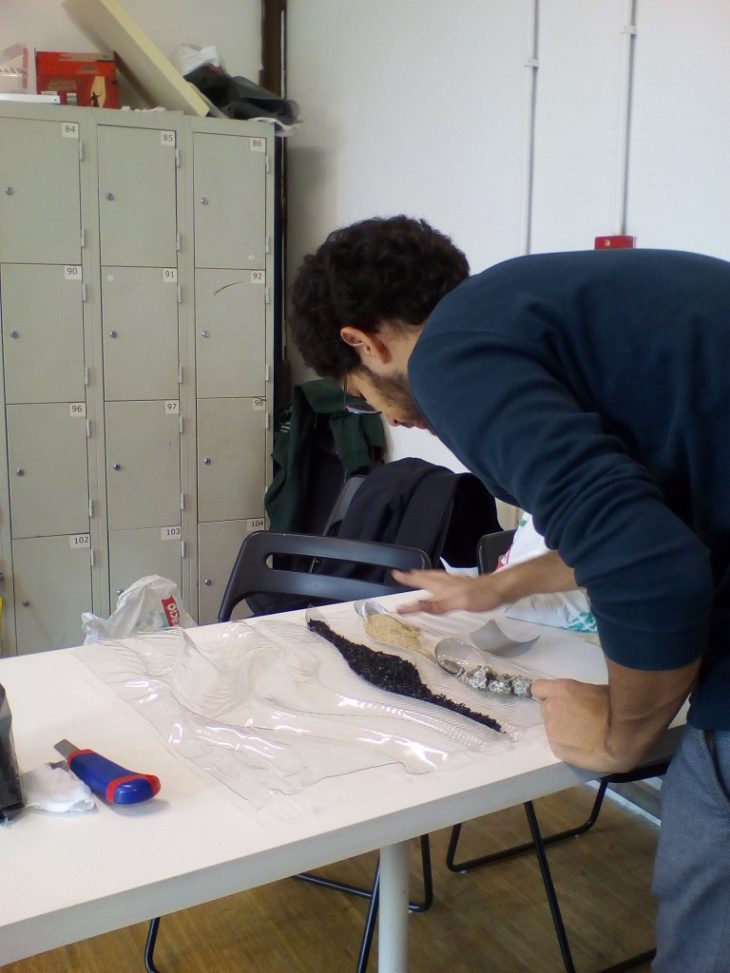
The final prototype combines the skin module with a street furniture to show the potential of applying it in an urban scale. It is made out of a series of wooden boards that makes up a bench, bike racks, and the structure to display the filtration skin modules.
The module is made out of three layers of thermoformed PETG sheets. The first two hold the water filter materials, and can be replaced easily. The third layer is fixed to the structure, and wraps around the UV lamp for disinfection and light tubes for street lighting.
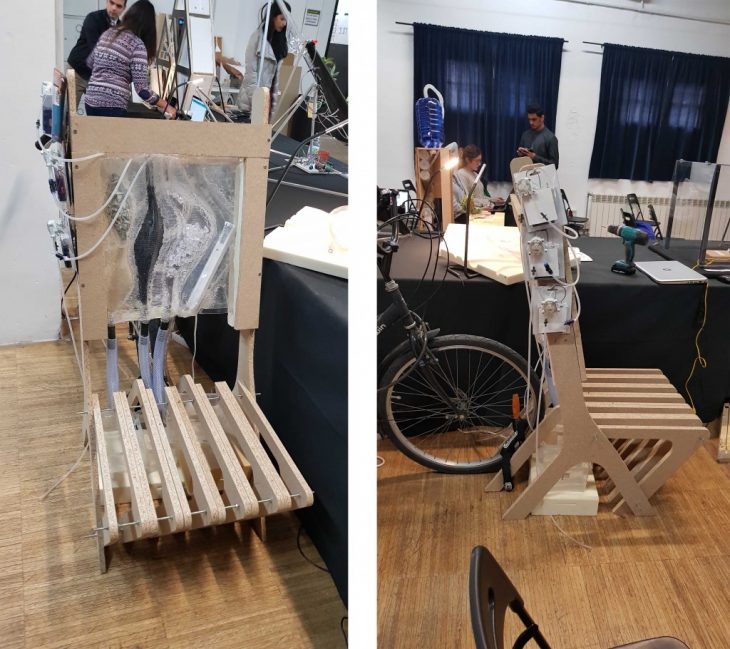
Final prototype presented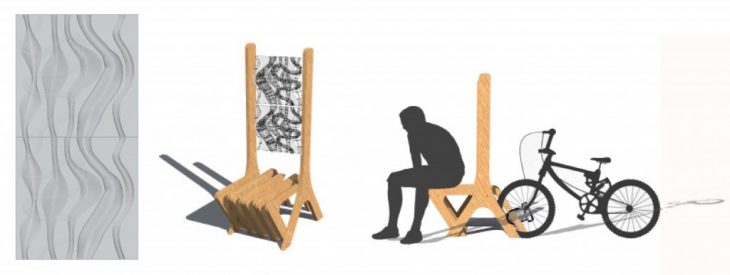
Zoom on the module and its cavities and 3D of the prototype
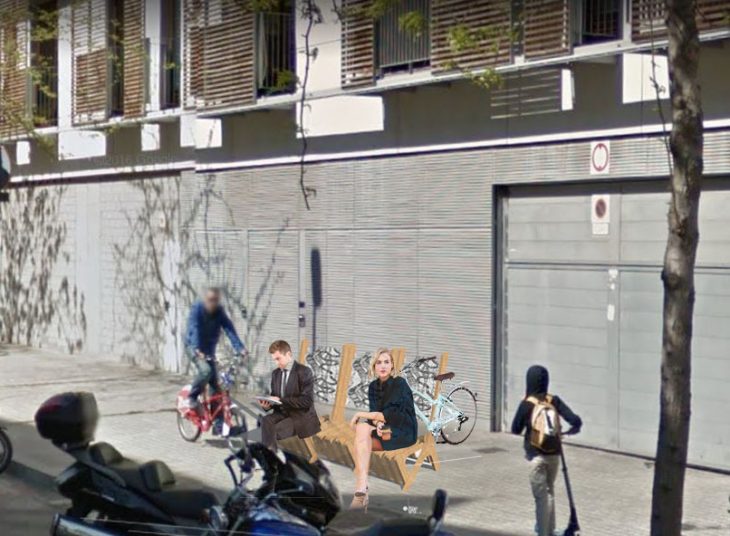
8- Proposal:
Re-imagining a street in the Superilla:
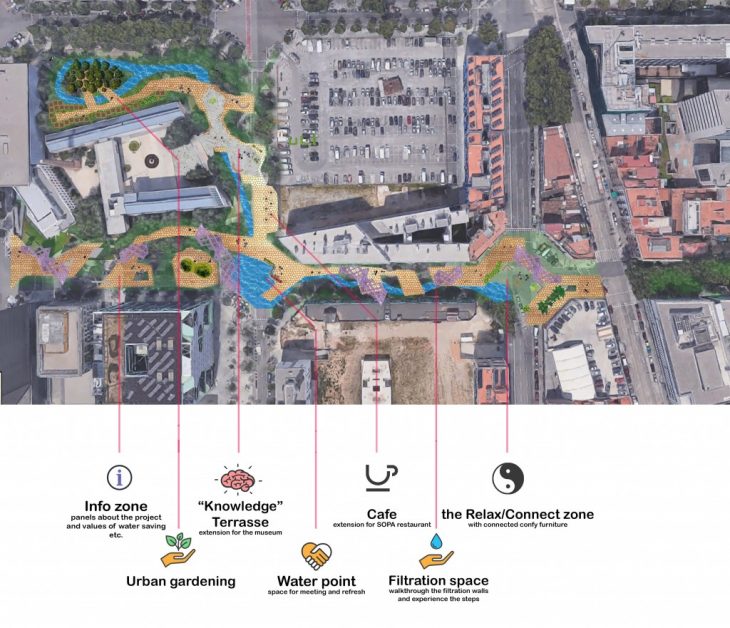
In this plan: the water is filtrated in the purple structures (holding the skin modules) that shapes the street by becoming benches, roofs, bike racks… (see next image), the water is redistributed to the buildings and the extra flow fills the Oasis. In periods of high demand in water some deep parts of the empty oasis could become an amphitheater or a skate park.
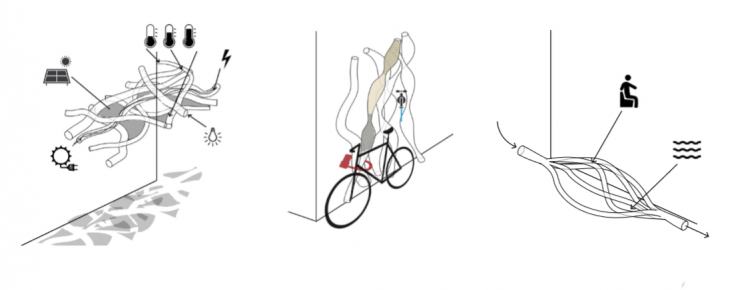
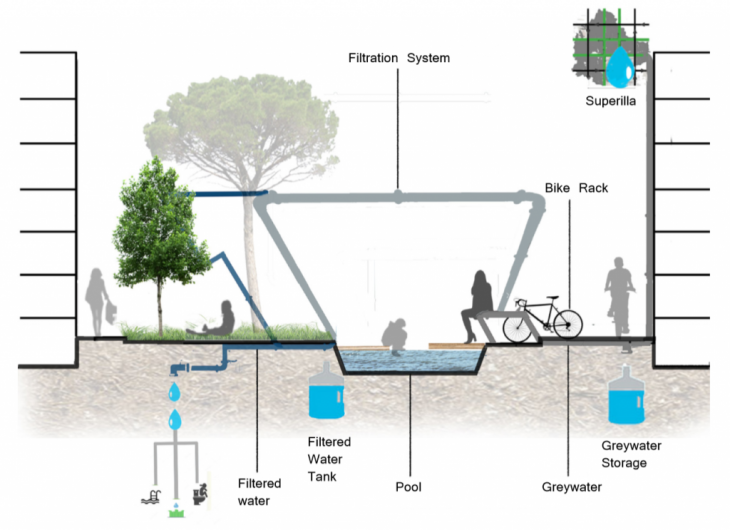
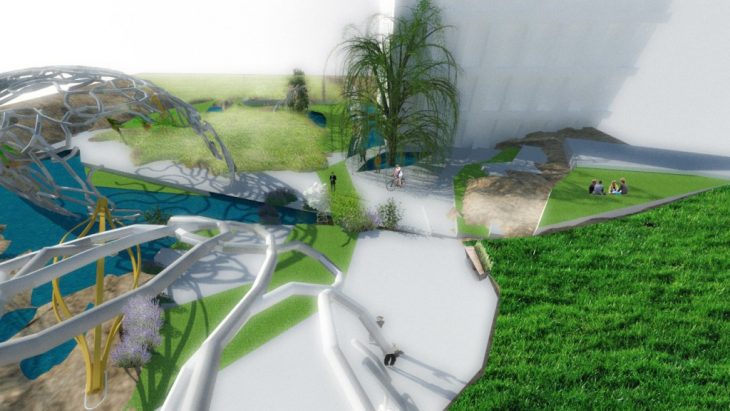
9- History of Water in Barcelona (Extra):
The Blue Gold, the oil of the 21st century1, the “elixir” of life, the two Hs and one O or more simply water, is the most important resource humans have. More than just vital for living organisms, it is considered a human right to access water2 nowadays. Water acquisition, management, distribution and drainage, has always been associated to different cultural practices, commodity, money and economic power.
Barcelona is an old city. Ruins of settlement go back to 5000 B.C., but the main trace of a complex society goes back to a colony named Barcino in the Roman empire. Roman cities consumed signifcantly more water per person than modern cities; water usage was the core of their culture.
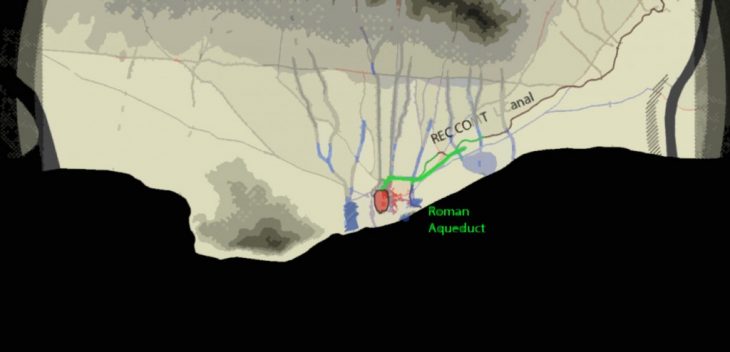
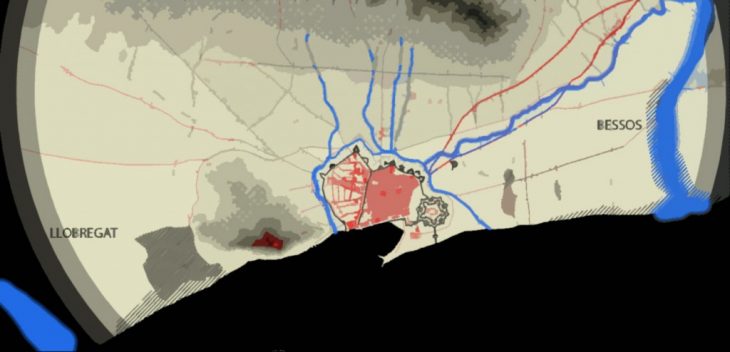
The source of water was important, since it has to provide water for different usages including baths, aqueducts and public fountains. Archeological studies3 show that water collection was made from natural sources in the Collserola Range and the Montcada mountains in Sant Joan. Specifically, at the mouth of the Tapioles stream, where the current limits of the municipalities of Montcada i Reixac, Barcelona and Santa Coloma de Gramenet converge4. This aqueduct was used until the 10th century, then the city started searching for new sources.
Although Hippocrates’s treaty “De aere, aquis, locis liber” (Air, Water and Places) doesn’t recommend the use of water from ice5, people collected ice in big wells along the roads linking Madrid to all port cities of Spain. This is where the old saying “the freshest fishes are in Madrid” comes from. These structures are still present in the Spanish and Catalonian landscape and were used until modern times (1907) when the first artificial production of ice appeared6. The city knew big expansions in the 13th century and water demand augmented. In the 15th century the effective supply depends on the sources of Collserola-Rovira.

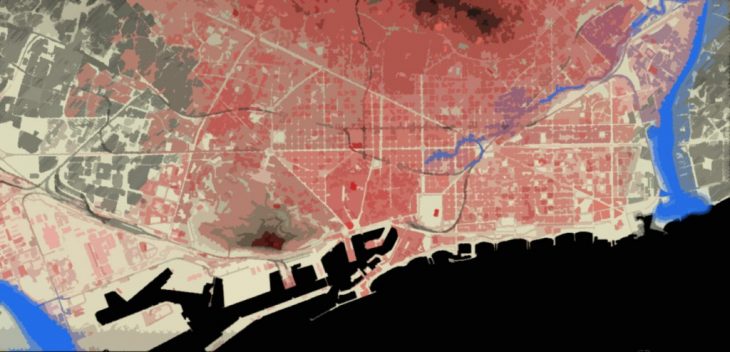
The 1776 drought and 1777 flood contributed to the start of capturing water of the Besòs river. Around 1879, private companies like the SGAB (Sociedad General de Aguas de Barcelona) helped irrigate the city, but later ownership of water problems occurred which led to unification of the price of water by the local “aguas de barcelona empresa”. In 1950, the Rec Comtal is transformed into the city sewer, and many shortage in supply led to the concession of using the Llobergat River by SGAB. Ten years later the Ter River was also rerouted to supply the city. Between 1930 and 1960, the number of water dams increased in all Spain.
Droughts hit again in 1973. Projects to derive the Ebro river were proposed but were contested until the 2000 when the final solution was to build the Prat de Llobregat and the River Tordera desalination plants which represents 20% of today’s consumption7. Since the 2000’s the city of Barcelona is studying new possibilities to harvest water, to clean it, to reuse it and to reduce the amount wasted through the smart water program, one of the 22 programs of Poblenou.
Project by:
STUDENTS:
Francois Nour
Yvonne Yifan Liao
Tawnza El Moujahid
FACULTY:
Javier Peña
Oriol Carrasco
Catalina Puello Acosta
